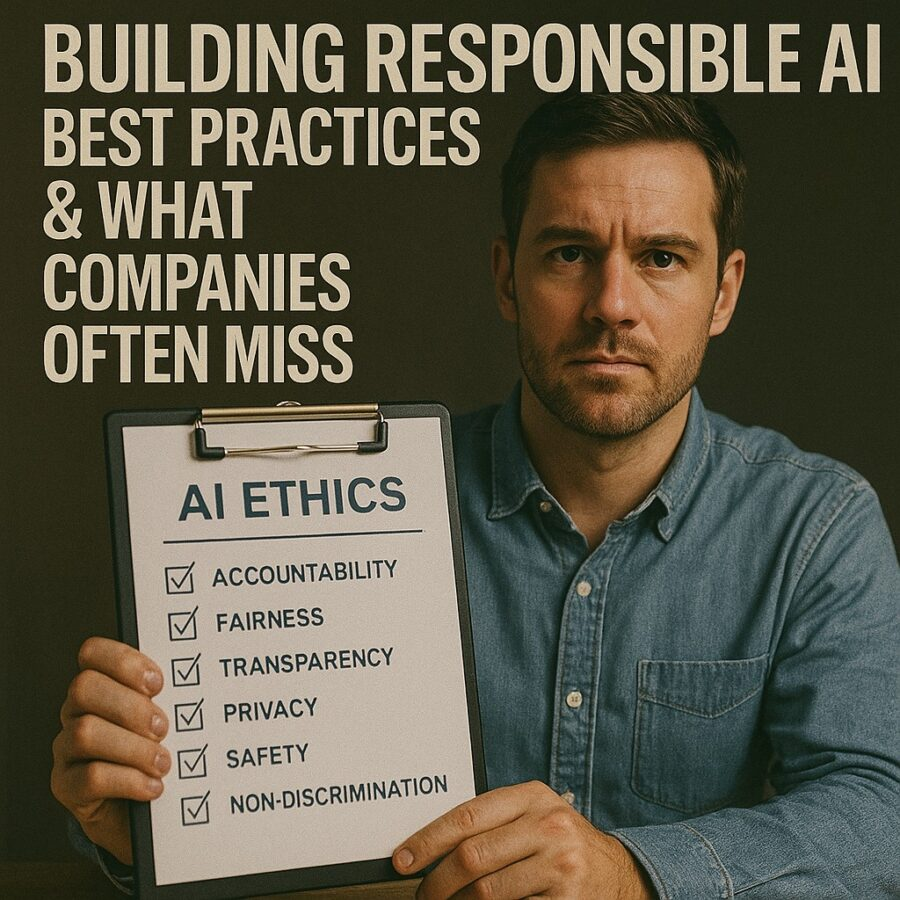Views: 4
Artificial intelligence is advancing rapidly, but progress brings responsibility. The ability of AI systems to generate content, make decisions, and influence human behavior makes them powerful. That power can also cause harm if left unchecked. The central challenge lies in building responsible AI, where innovation aligns with safety, fairness, and trust. While many organizations adopt ethical principles, their actions often fall short of their intentions.
This article examines the best practices that define responsible development, highlights the common mistakes companies make, and outlines the path toward truly accountable AI systems.
Why Building Responsible AI Matters
AI is no longer confined to research labs. It powers recommendation engines, medical tools, financial platforms, and creative applications. When these systems work well, they enhance productivity and expand access. When they fail, the consequences range from biased hiring decisions to misinformation and even security breaches.
The question is not whether AI should advance but how it should advance. Building responsible AI ensures that technology strengthens society rather than undermines it. Without responsibility, public trust erodes, and innovation becomes unsustainable.
The Foundations of Responsible AI
Responsible AI rests on several foundational principles that guide design and deployment.
Transparency
Users should understand how AI systems make decisions. Clear documentation of data sources, model limitations, and decision-making processes is essential.
Fairness
Bias in algorithms can reinforce discrimination. Diverse datasets and rigorous testing across demographic groups reduce unfair outcomes.
Accountability
Companies must take responsibility for their systems. This includes mechanisms to contest AI-driven decisions and processes for redress when harm occurs.
Privacy
Respecting user data is non-negotiable. Responsible AI minimizes data collection, uses anonymization where possible, and protects sensitive information.
Together, these principles form the baseline for building responsible AI, but applying them in practice is where organizations often falter.
The following is a referral program where AltPenguin receives compensation if you use the link and complete the offer (click the image to open the link in a new page).
Best Practices for Building Responsible AI
Several practices can turn principles into meaningful outcomes.
1. Ethics from the Start
Ethics should be part of the design phase, not an afterthought. Teams must evaluate potential harms before launching models into production. Scenario planning helps identify risks early.
2. Diverse Teams
Homogeneous teams may overlook bias or ethical blind spots. Including voices from different backgrounds ensures systems are tested against varied perspectives.
3. Continuous Auditing
AI is not static. Models evolve as they interact with new data. Regular audits track performance and identify emerging risks. Transparency reports can share results with stakeholders.
4. Explainability Tools
Users should not face black-box decisions. Techniques such as feature attribution and natural language explanations make AI outputs more understandable.
5. Cross-Sector Collaboration
Partnerships with academia, regulators, and civil society broaden accountability. Independent oversight ensures that best practices extend beyond corporate walls.
These steps illustrate how building responsible AI moves from slogans to sustainable practice.
What Companies Often Miss
Despite adopting ethical charters, many organizations miss critical elements.
Treating Ethics as Marketing
Some companies use “AI ethics” as a branding exercise without changing internal practices. Responsibility cannot be a public relations strategy. It must be embedded in operations.
Overlooking Supply Chains
AI depends on vast labor networks, from data labelers to content moderators. Ignoring the working conditions of this hidden workforce undermines claims of responsibility.
Ignoring Small Harms
Firms often focus on catastrophic risks, such as autonomous weapons, while neglecting everyday harms like biased hiring or unfair credit scoring. Small harms at scale can affect millions.
Failing to Engage Users
Responsible AI requires feedback loops with the people who use or are affected by the system. Many companies skip this step, treating users as passive recipients rather than active stakeholders.
Underestimating Long-Term Risks
Companies frequently optimize for short-term profit rather than long-term safety. This mindset leads to reactive fixes rather than proactive safeguards.
These oversights reveal why building responsible AI remains difficult despite widespread acknowledgment of its importance.
Case Studies of Responsible and Irresponsible AI
Examining real-world examples helps clarify the stakes.
- Healthcare AI: Some diagnostic tools have shown racial disparities in accuracy. When developers ignored diverse training data, patients suffered unequal care. This illustrates the danger of neglecting fairness.
- Financial Services: Robo-advisors that clearly explain portfolio decisions build trust. Those that hide behind opaque models erode confidence. Transparency proves vital.
- Social Media: Platforms deploying AI to moderate harmful content face criticism when moderators endure psychological harm from reviewing traumatic material. Responsible AI requires caring for the humans behind the system.
Each case reinforces the idea that building responsible AI is about anticipating real-world effects, not just technical performance.
The following is a referral program where AltPenguin receives compensation if you use the link (click the image to open the link).
The Role of Regulation
Governments worldwide are drafting laws to govern artificial intelligence. The European Union’s AI Act categorizes applications by risk and imposes strict requirements for high-risk systems. In the United States, federal agencies issue sector-specific guidance. China enforces rules aligned with political priorities.
While regulation adds accountability, companies cannot rely on laws alone. The pace of innovation outstrips legal frameworks. Organizations must act responsibly even in the absence of mandates. Building responsible AI requires self-regulation as well as compliance with external rules.
The Human Element
At its core, AI serves human purposes. Keeping people at the center ensures systems remain aligned with societal values.
- Human-in-the-loop models combine machine efficiency with human judgment.
- User education empowers individuals to understand AI decisions and contest them.
- Cultural sensitivity acknowledges that responsibility may look different across societies.
Placing humans at the heart of design and oversight is essential for building responsible AI that truly serves diverse populations.
Future Directions for Responsible AI
Looking ahead, several trends will shape the next phase of responsible development.
Value Alignment
Researchers are exploring ways to align AI with human values, ensuring systems act consistently with ethical norms.
Sustainable AI
Energy consumption will demand greater attention. Companies must design models that balance performance with environmental impact.
Global Standards
International cooperation could establish shared benchmarks for transparency, fairness, and accountability.
Responsible Agents
As AI shifts from tools to autonomous agents, responsibility must evolve. Systems that act independently will require new frameworks for liability and oversight.
These directions illustrate that building responsible AI is an ongoing process, not a fixed endpoint.
The Cost of Neglect
Failing to act responsibly carries tangible costs.
- Reputation damage: Companies deploying biased or harmful AI face public backlash.
- Legal penalties: Non-compliance with emerging regulations risks fines and restrictions.
- Loss of trust: Users abandon platforms that misuse data or deliver unfair outcomes.
The price of ignoring responsibility outweighs the cost of implementation. This reality makes building responsible AI not just ethical but strategic.
A Path Forward
The journey toward responsible AI requires integration across technology, culture, and governance.
- Commit to principles but enforce them with action.
- Design systems with humans in mind.
- Audit regularly and transparently.
- Collaborate across sectors and borders.
- Anticipate long-term risks as much as short-term profit.
By following this path, organizations can move beyond rhetoric and demonstrate genuine accountability.
The following is a referral program where AltPenguin receives compensation if you use the link (click the image to open the link).
Closing Thoughts
Artificial intelligence holds extraordinary promise, but promise without responsibility becomes peril. The debate over building responsible AI is not a theoretical exercise. It is about whether the systems shaping society will reflect fairness, transparency, and human dignity.
Best practices provide a roadmap, but companies often miss critical steps that transform ideals into reality. The difference between responsible and irresponsible AI lies in the details: the labor behind the systems, the overlooked harms, and the engagement with those most affected.
The future will not be shaped solely by what AI can do but by how it is guided. Building responsibly ensures that technology becomes a tool for empowerment rather than exploitation. The responsibility belongs to all of us—engineers, executives, regulators, and citizens alike.




](https://altpenguin.com/wp-content/uploads/2025/08/veed-ad.webp)
